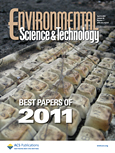Environmental Science and Technology 46(7)
Overview of new articles on POPs in a new issue of the Environmental Science & Technology journal.

Yuan Gao, Haijun Zhang, Fan Su, Yuzeng Tian, and Jiping Chen
pp 3771–3778
- Chlorinated paraffins (CPs) are industrially produced in large quantities in the Liaohe River Basin. In this study, short chain CPs (SCCPs) were analyzed in sediments, paddy soils, and upland soils from the Liaohe River Basin, with concentrations ranging from 39.8 to 480.3 ng/g dry weight.
Yuqiang Tao, Bin Xue, Shuchun Yao, Jiancai Deng, and Zhifan Gui
pp 3851–3858
- Although numerous studies have addressed sequestration of hydrophobic organic compounds (HOCs) in laboratory, little attention has been paid to its evaluation method in field at large temporal scale. A biomimetic tool, triolein embedded cellulose acetate membrane (TECAM), was therefore tested to evaluate sequestration of six PAHs with various hydrophobicity in a well-dated sediment core sampled from Nanyi Lake, China.
Temporal Trends of Persistent Organic Pollutants: A Comparison of Different Time Series Models
Marta Venier, Hayley Hung, Włodzimierz Tych, and Ronald A. Hites
pp 3928–3934
- We analyzed the vapor phase atmospheric concentrations of representative persistent chemicals (i.e., α- and γ-hexachlorocyclohexane, phenanthrene, PCB-18 and PCB-52) in samples collected at a remote site near Eagle Harbor, Michigan, and at an urban site in Chicago, Illinois, using four time series models: a modified Clausius–Clapeyron equation, a multiple linear regression that includes both a linear and an harmonic dependence on time, digital filtration (DF), and dynamic harmonic regression (DHR).
Mohammed A. Khairy and Rainer Lohmann
pp 3990–3998
- Polyethylene samplers (PEs) were deployed at 11 locations in Alexandria, Egypt during summer and winter to test and characterize them as passive samplers for concentrations, sources, and seasonal variations of atmospheric concentrations of polycyclic aromatic hydrocarbons (PAHs). PE–air equilibrium was attained faster for a wider range of PAHs during the winter season possibly due to increased wind speeds.
Kiran Bala, Birgit Geueke, Milena E. Miska, Daniel Rentsch, Thomas Poiger, Mandeep Dadhwal, Rup Lal, Christof Holliger, and Hans-Peter E. Kohler
pp 4051–4058
- α-, β, γ-, and δ-Hexachlorocyclohexane (HCH), the four major isomers of technical HCH, are susceptible to biotic transformations, whereby only α- and γ-HCH undergo complete mineralization. Nevertheless, LinA and LinB catalyzing HCl elimination and hydrolytic dehalogenations, respectively, as initial steps in the mineralization also convert β- and δ-HCH to a variety of mainly hydroxylated metabolites. In this study, we describe the isolation of two minor components of technical HCH, ε-HCH, and heptachlorocyclohexane (HeCH), and we present data on enzymatic transformations of both compounds by two dehydrochlorinases (LinA1 and LinA2) and a haloalkane dehalogenase (LinB) from Sphingobium indicum B90A.
Characterization and Inventory of PCDD/F Emissions from the Ceramic Industry in China
Mang Lu, Guoxiang Wang, Zhongzhi Zhang, and Youming Su
pp 4159–4165
- The ceramic industry is considered to be a potential source of dioxins (polychlorinated dibenzo-p-dioxins and dibenzofurans (PCDD/Fs), considering the widespread distribution of dioxins in kaolinitic clays. Nevertheless, studies on the emission of dioxins from the ceramic industry are still very scarce. In this study, raw clays and stack gases from six typical ceramic plants in China were collected and analyzed to estimate the emission of dioxins from the ceramic industry.
Eunha Hoh, Richard N. Hunt, Penelope J. E. Quintana, Joy M. Zakarian, Dale A. Chatfield, Beth C. Wittry, Edgar Rodriguez, and Georg E. Matt
pp 4174–4183
- Environmental tobacco smoke is a major contributor to indoor air pollution. Dust and surfaces may remain contaminated long after active smoking has ceased (called ‘thirdhand’ smoke). Polycyclic aromatic hydrocarbons (PAHs) are known carcinogenic components of tobacco smoke found in settled house dust (SHD). We investigated whether tobacco smoke is a source of PAHs in SHD.
4.4.2012




